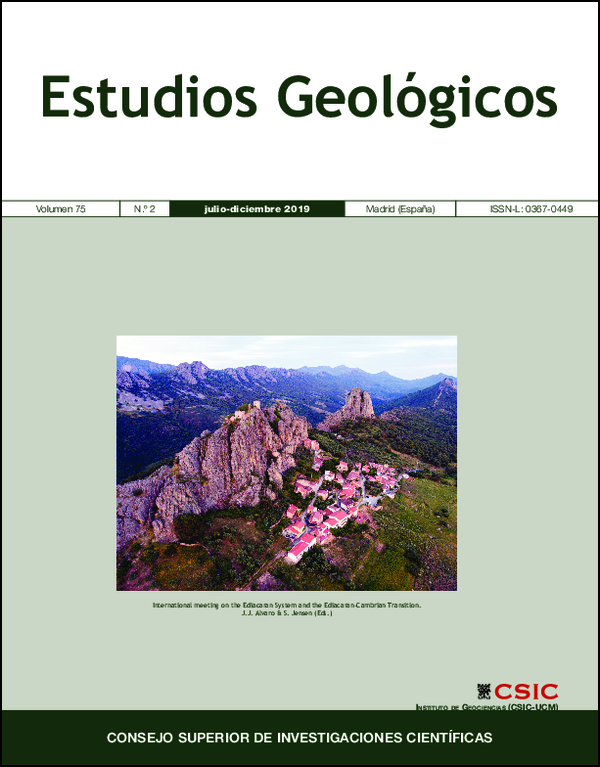Assessing the Ediacaran Doushantuo Formation: Improving stratigraphic correlation of the Upper Doushantuo Black Shales via mercury content
DOI:
https://doi.org/10.3989/egeol.43595.562Keywords:
Mercury, Organic carbon content, Doushantuo Formation, Ediacaran, ChinaAbstract
Mercury enrichments in the black shale unit of the Ediacaran Doushantuo Formation are, likely the result of volcanic input or anoxia-driven mercury deposition. If the Hg enrichments are volcanic in origin, or are due to synchronous regional anoxia, then the patterns of Hg enrichment are consistent with the conventional correlation of these units, with the tripartite units equivalent to Member IV black shales. Additionally comparing redox proxy data from the intervals of Hg enrichment could indicate if the enrichments are due to comparable changes in redox conditions, or increased Hg input under differing redox conditions, consistent with volcanic input.
Downloads
References
An, Z.; Jiang, G.; Tong, J.; Tian, L.; Ye, Q.; Song, H. & Song, H. (2015). Stratigraphic position of the Ediacaran Miaohe biota and its constraints on the age of the upper Doushantuo ?13C anomaly in the Yangtze Gorges area, South China. Precambrian Research, 271: 243-253. https://doi.org/10.1016/j.precamres.2015.10.007
Marshall, C.R. (2006). Explaining the Cambrian "Explosion" of Animals. Annual Review of Earth & Planetary Sciences, 34: 355-384. https://doi.org/10.1146/annurev.earth.33.031504.103001
McFadden, K. A.; Huang, J.; Chu, X.; Jiang, G.; Kaufman, A. J.; Zhou, C.; Yuan, X. & Xiao, S. (2008). Pulsed oxidation and biological evolution in the Ediacaran Doushantuo Formation. Proceedings of the National Academy of Sciences, 105: 3197-3202. https://doi.org/10.1073/pnas.0708336105 PMid:18299566 PMCid:PMC2265117
Muscente, A.; Hawkins, A.D. & Xiao, S. (2015). Fossil preservation through phosphatization and silicification in the Ediacaran Doushantuo Formation (South China): a comparative synthesis. Palaeogeography, Palaeoclimatology, Palaeoecology, 434: 46-62. https://doi.org/10.1016/j.palaeo.2014.10.013
Selin, N.E. (2009). Global biogeochemical cycling of mercury: a review. Annual Review of Environment Resources, 34: 43-63. https://doi.org/10.1146/annurev.environ.051308.084314
Thibodeau, A.M.; Ritterbush, K.; Yager, J.A.; West, A.J.; Ibarra, Y.; Bottjer, D.J.; Berelson, W.M.; Bergquist, B.A. & Corsetti, F.A. (2016). Mercury anomalies and the timing of biotic recovery following the end-Triassic mass extinction. Nature Communications, 7: 11147. https://doi.org/10.1038/ncomms11147 PMid:27048776 PMCid:PMC4823824
Zhou, C.; Xiao, S.; Wang, W.; Guan, C.; Ouyang, Q. & Chen, Z. (2017). The stratigraphic complexity of the middle Ediacaran carbon isotopic record in the Yangtze Gorges area, South China, and its implications for the age and chemostratigraphic significance of the Shuram excursion. Precambrian Research, 288: 23-38. https://doi.org/10.1016/j.precamres.2016.11.007
Published
How to Cite
Issue
Section
License
Copyright (c) 2019 Consejo Superior de Investigaciones Científicas (CSIC)

This work is licensed under a Creative Commons Attribution 4.0 International License.
© CSIC. Manuscripts published in both the print and online versions of this journal are the property of the Consejo Superior de Investigaciones Científicas, and quoting this source is a requirement for any partial or full reproduction.
All contents of this electronic edition, except where otherwise noted, are distributed under a Creative Commons Attribution 4.0 International (CC BY 4.0) licence. You may read the basic information and the legal text of the licence. The indication of the CC BY 4.0 licence must be expressly stated in this way when necessary.
Self-archiving in repositories, personal webpages or similar, of any version other than the final version of the work produced by the publisher, is not allowed.















